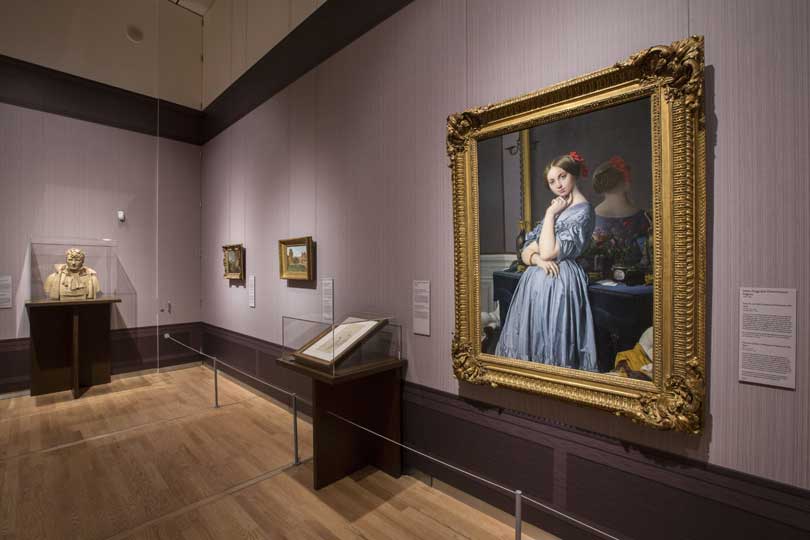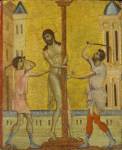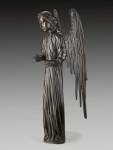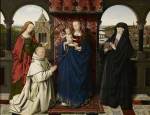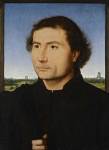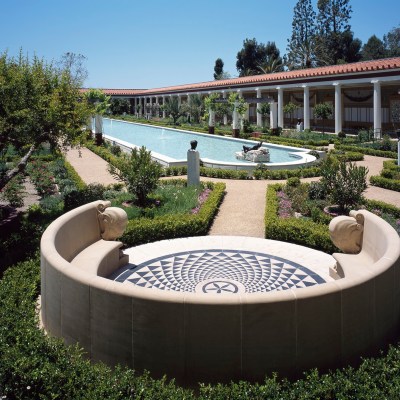In 1896 the steel magnate and art collector Henry Clay Frick took a tour of the Netherlands, stopping at The Hague. Whether he visited the Mauritshuis is not known. What is certain is that three years later he began buying Dutch paintings, starting with Portrait of a Young Artist (1650s; a follower of Rembrandt) and ending with Johannes Vermeer’s Mistress and Maid (1666/7) in 1919, the year of his death. The works he collected by Vermeer, Rembrandt, Frans Hals, Van Dyck and Meindert Hobbema are central treasures of the Frick Collection.
When Helen Clay Frick retraced her father’s footsteps 36 years later, she was personally conducted around the Mauritshuis by its director Wilhelm Martin, and stuck in her scrapbook images including The Goldfinch (1654) by Carel Fabritius, Johannes Vermeer’s Girl with a Pearl Earring (1665) and Jan Steen’s ‘As the Old Sing, So Pipe the Young’ (c. 1668–70). Last winter, while the Mauritshuis was undergoing a two-year renovation, these three paintings were loaned to the Frick alongside 12 others. It was the first time they had travelled in nearly 30 years. Visitors queued around the block to see the celebrated works.
This spring the Frick has repaid the favour. For the first major art exhibition in its much-admired new space, the Mauritshuis has secured the loan of 36 exceptional works of art from the New York institution. This is the first time the Frick has lent a substantial group of works for a travelling exhibition. It is gesture not just of immediate gratitude but of mutual recognition that the two institutions – with their small but outstanding collections, largely reflecting the taste of single individuals or families, in landmark buildings created as private homes – share characteristics. Furthermore, the sympathy among American collectors from the Gilded Age, including Frick, for masterpieces of the Dutch Golden Age was not accidental; they recognised that their nation was standing at a similar point in its history as Holland had in its prime moment of mercantile expansion.
Restricted by the terms of Frick’s bequest from lending works donated by Henry Clay Frick personally, the organisers have selected objects and paintings that reflect the different strands of collecting after his death in 1919. Almost a third of the works in the Frick Collection are posthumous acquisitions that, while taking their cue from the collecting interests of Henry Clay, also reflect the passions of Helen Clay for early Italian Renaissance masters (for instance), and the interests of subsequent curators.
It is perhaps surprising to learn that some 80% of the items in the Frick Collection are not paintings at all, but sculptures, decorative arts, drawings, bronzes and so on. One of the most spectacular loans is an elaborate gilt brass and silver table clock created by Augsburg clockmaker David Weber in 1653. The Frick has also lent its iconic bronze Angel (1475) by Jean Barbet, plus examples of majolica and Sèvres porcelain, laid out on tables to conjure up their domestic setting in New York. The Mauritshuis was especially keen to borrow examples of work by artists barely or not at all represented in public collections in the Netherlands. It is a particular treat to see Cimabue’s tender Flagellation of Christ (c. 1280), bought by the Frick in 1950, and the exquisite and sober Virgin and Child, with Saint Barbara, Saint Elizabeth of Hungary and Jan Vos by Jan van Eyck and Workshop (c. 1441–43).
Portrait of the Comtesse d’Haussonville (1845), Jean-Auguste-Dominique Ingres. The Frick Collection, New York; photo: Michael Bodycomb

For the occasion, the Mauritshuis has laid out its temporary exhibition space in homage to the Frick’s long West Gallery, echoing the architecture and style of display. The first painting that catches your eye is the marvellously assured and coquettish Portrait of the Comtesse d’Haussonville (1845) by Ingres – an artist unrepresented in Holland’s public collections – displayed alongside a preparatory study. There are also portraits by Reynolds and Gainsborough, a Portrait of a Man (c. 1470) by Hans Memling to rival the Mauritshuis’ own, and a landscape and two cloud studies by Constable, alongside a more familiar Landscape with a Footbridge by Jacob van Ruisdael from 1652.
Paintings and objects are mixed and matched with a poetic eye that looks beyond chronology or nationality, and Frick’s evident love of portraits and landscapes over historical or mythological scenes is balanced by a desire to complement the collections of the host museum. The Frick is not unhappy at its temporary loss. The loan offers a rare opportunity for the New York museum to display its important collection of tapestries on the vacated walls. Moreover, the director Ian Wardropper has embraced the chance to see the Frick’s works in a quite different context. As he puts it, ‘I am learning new things about paintings I thought I knew quite well!’
‘The Frick Collection: Art Treasures from New York’ is at the Mauritshuis, The Hague, until 10 May.
Related Articles
12 Days: Mauritshuis director Emilie Gordenker selecters some highlights of 2015
Reopening the jewel box: the Mauritshuis opens its doors (Louise Nicholson)
The Hague’s Hidden Treasures: Gemeentemuseum den Haag and the Het Paleis
The Hague’s Hidden Treasures: Prince William V’s Picture Gallery
The Hague’s hidden treasures: Museum Bredius
Outstanding Renaissance and Baroque Bronzes at the Frick Collection (David Ekserdjian)
